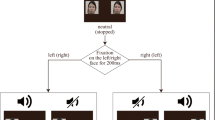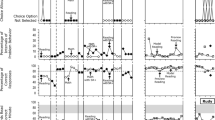Abstract
An experimental study designed to determine the effects of non-contingent and contingent reinforcement of eye contact on the behavior of a 41/2-year-old autistic boy is presented after a brief critical review of pertinent literature. Rate changes in 20 types of behavior comprising a variety of simple responses, contacts, vocalizations, verbalizations or movements under the two reinforcement conditions and during baseline, were recorded and compared. Significant changes were found in the frequency of vocalization, eye contact, and when the child placed his hands over ears. It is suggested that when many types of behavior are examined simultaneously there are some which show as marked a change during non-contingent as during contingent reinforcement. Reinforcement could be a setting stimulus changing the child's expectations and prompting many changes in behavior that might be thought to result from the reinforcement procedure.
Similar content being viewed by others
References
Ayllon, T., & Azrin, N. H. The measurement and reinforcement of behavior of psychotics.Journal of the Experimental Analysis of Behavior, 1965,8, 357–383.
Bijou, S. W., & Baer, D. M. Operant methods in child behavior and development. In W. K. Honig (Ed.),Operant behavior: Areas of research and application. New York: Appleton-Century-Crofts, 1966.
Bushell, D., Jr., Robel, P. A., & Michaelis, M. L. Applying group contingencies of the classroom study of behavior of preschool children.Journal of Applied Behavior Analysis, 1968,1, 55–61.
Etzel, B. C., & Gewirtz, J. L. Experimental modification of caretaker-maintained high rate operant crying in a six and a twenty week old infant. Infant tyrannotearus: Extinction of crying with reinforcement of eye contact and smiling.Journal of Experimental Child Psychology, 1967,5, 303–317.
Hart, D. M., Reynolds, N. J., Baer, D. M., Brawley, E. R., & Harris, F. R. Effect of contingent and non-contingent social reinforcement on the cooperative play of a preschool child.Journal of Applied Behavior Analysis, 1968,1, 73–76.
Hart, D. M., & Risley, T. R. Establishing use of descriptive adjectives in the spontaneous speech of disadvantaged preschool children.Journal of Applied Behavior Analysis, 1968,1, 109–120.
Herrnstein, R. J. Superstition: A corollary to the principles of operant conditioning. In W. K. Honig (Ed.),Operant behavior: Areas of research and application. New York: Appleton-Century-Crofts, 1966.
Lovaas, O. I., Freitag, G., Gold, V. J., & Kassorla, I. C. Experimental studies in childhood schizophrenia.Journal of Experimental Child Psychology, 1965,2, 67–84.
McConnell, O. L. Control of eye contact in an autistic child.Journal of Child Psychology and Psychiatry, 1967,8, 249–255.
Metz, J. R. Conditioning generalized imitation in autistic children.Journal of Experimental Child Psychology, 1965,2, 389–399.
Ney, P. G. Operant conditioning of schizophrenic children.Journal of Canadian Psychiatric Association, 1967,12, 9–15.
Ney, P. G., Palvesky, A. E., & Markely, J. Relative effectiveness of operant conditioning and play therapy in childhood schizophrenia.Journal of Autism and Childhood Schizoprehnia, 1971,1, 337–349.
Rheingold, H. L. Effect of environmental stimulation upon social exploratory behavior in the human infant. In F. M. Foss (Ed.),Determinants of infant behaviour. New York: Wiley, 1961.
Rheingold, H. L., Stanley, W. C., & Cooley, J. A. Method of studying exploratory behavior in infants.Science, 1962,136, 1054–1055.
Risley, T. R., & Wolf, M. M. Experimental manipulation of autistic behaviors and generalization into the home. In S. W. Bijou & D. M. Baer (Eds.),Child development: Readings in experimental analysis. New York: Appleton-Century-Crofts, 1967.
Robson, K. S. The role of eye to eye contact in maternal infant attachment.Journal of Child Psychology and Psychiatry, 1967,8, 13–25.
Scheffe, H.The analysis of variance. New York: Wiley, 1959.
Sherman, J. A. Modification of non-verbal behavior through reinforcement of related verbal behavior.Child Development, 1964,35, 717–723.
Author information
Authors and Affiliations
Rights and permissions
About this article
Cite this article
Ney, P.G. Effect of contingent and non-contingent reinforcement on the behavior of an autistic child. J Autism Dev Disord 3, 115–127 (1973). https://doi.org/10.1007/BF01537987
Issue Date:
DOI: https://doi.org/10.1007/BF01537987




